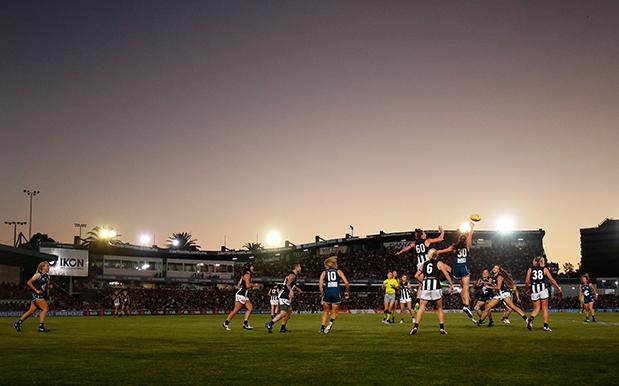
Well that was a bit bloody special, wasn’t it?
It’s hard to pick what the story of the weekend was: The over-capacity crowd of 25,000 that crammed into Princes Park on Friday night, harking back to football’s suburban glory days with people sitting in the aisles and climbing over the fence just to get in; Darcy Vescio‘s barnstorming performance in the league’s debut game; the western suburbs roaring as a new breed of Bulldog emerged from the kennel; Erin Phillips‘ absurd toughness in absorbing two ferocious head-high charges and standing up from both immediately.
You could even argue that the weekend belonged to Sarah Perkins: the instant cult favourite of the Adelaide faithful who shed 40kgs in 18 months just to get a sniff of the big time, went undrafted, uprooted her life from Melbourne with absolutely no guarantees, and then starred in the first chance she got.
Any one of those things, on any given weekend, would have stood tall as the central talking point.
That they all happened in the stretch of one lone weekend is nothing short of remarkable.
The first round of the AFLW proved a success beyond anyone’s wildest dreams, not only from a pure numbers standpoint, but an on-field one as well.
Attendance-wise, the people voted with their feet. Across four games of the inaugural round, over 50,000 combined fans poured into grounds in both Melbourne and Adelaide.
The sheer amount of people who crammed into stadiums went far and above what the AFL had estimated, and enormous queues that formed outside grounds hours before the opening siren were common sights.
On Friday night, the AFL expected the Carlton vs Collingwood clash at Princes Park to draw 10,000 fans. It got 24,568.
On Saturday at Thebarton Oval, the league expected Adelaide vs GWS to pull in 5,000. They got 9,468.
Saturday night in Footscray, they expected the Western Bulldogs vs Fremantle game to attract 6,000 fans. They got 10,100.
And in fact, the only thing preventing Sunday’s Melbourne vs Brisbane game from pulling even more people to Casey Fields in Melbourne’s deep south-east was a lightning storm and torrential rain that forced play to be halted momentarily just prior to half time. Despite that, 6,500 fans still showed up.
The numbers wins didn’t end there, either. TV ratings heralded the new league as a potential force of weekend broadcasting. 896,000 combined viewers for Friday night’s game broadcast live and in prime-time on Channel Seven, including a Melbourne metropolitan audience on-par with any Friday night game of the men’s regular season. Saturday’s games were no different, with a combined peak national audience of 885,000 showing interest was not a mere one-off.
Seven’s coverage was impeccable. Far beyond the too-often blokey coverage over-saturated by former players that dogs the men’s broadcasts, the commentary was restrained, the insight useful, and the presentation warm and colloquial. Patrick Dangerfield‘s no-nonsense analysis should have every 7Sport exec sitting upright. Sam Lane is, as always, a damned treat. Neroli Meadows handled boundary riding duties like the true professional she is. And Tegan Higginbotham‘s pre-game presence straddled the line between comedic relief and serious sports journalism as well as – if not better than – anyone on an AFL telecast in recent memory.
But the most important win was on-field.
It’s important to understand that this isn’t just a new, elite national competition. It’s a pathway. Players in this league, for the most part, had nowhere to play and develop between the ages of 14 and 18. This year’s upcoming draft class, for example, is the first crop of women players who have been able to play from Auskick and junior levels right through to senior football. In the case of Erin Phillips – an elite athlete in her own right – this was her first “serious” game of football in 8 years.
That didn’t stop any of the players this weekend, though.
Tough, uncompromising, defensively-focused (if not scrappy) football that was enthralling from siren-to-siren, even despite the comparatively low scores. The sudden influx of AFL-grade coaching, with its heavy focus on defensive pressure and +1s in the back 50, saw league standouts Daisy Pearce and Moana Hope largely shut out of their respective games.
The women’s game is tight and tough, rewarding speed and anyone willing to charge through a pack; and in that regard there were no shortage of volunteers.
It’s an honest and fair brand of football; it took over a game-and-a-half for the league’s first 50 metre penalty to be handed out. And through four games, only one incident will come under scrutiny from the Match Review Panel.
But perhaps above all else, it was the atmosphere at the ground that stood out the most. It was welcoming, warm, inclusive, and celebratory. It had none of the rough, vitriolic, intimidating edge that can sometimes cast an ominous shadow over the crowd at the MCG. Gone were the braying lunatics hurling ungodly abuse at the umpires, replaced by families – and more importantly women and girls in their thousands, at long last embracing the chance to be represented in the sport they love on a national, professional scale.
The change and swiftness of this revolution perhaps no better summed up than with footy icon and Footscray stalwart Susan Alberti accidentally singing “’cause you can’t beat the *boys* of the Bulldog breed” as her women’s Footscray charges celebrated Saturday night’s win.
It’s all come in a big rush, and there’s certainly work still to be done, but the impact of this weekend is undeniable. The voices of stubborn detractors and sexist critics drowned out by the 50,000+ who poured into stadiums and the many, many more who watched at home.
The future of football is female. Bring on round two.
Photo: Adam Trafford, AFL Media/Getty.



